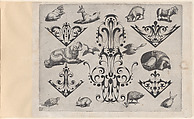Blackwork Designs with Various Mammals and Birds, Plate 5 from a Series of Blackwork Ornaments combined with Figures, Birds, Animals and Flowers
Artist and engraver Meinert Gelijs Dutch
After Jakob Hoefnagel German
After Jacques Callot French
Not on view
Plate 5 from a print series consisting of a title page (missing) and seven numbered plates displaying motifs for the application in goldsmith's work, executed in blackwork, combined with figures and other motifs borrowed from other print series, executed in engraving. This plate contains five distinct motifs in blackwork, with a large design in the center of the plate and two smaller designs on either side. The smaller motifs all have a sharp 90 degree angle at bottom, suggesting that they are meant for the decoration of corners. Surrounding the blackwork motifs are engraved figures of various mammals including dogs, bunnies and a pig, as well as several birds.
Due to the similarity in their production techniques, blackwork prints often relate to precious objects decorated with champlevé enamel work. However, on the title page of his second series, characterized by the almost square copperplates and exclusive use of the blackwork technique, Gelijs indicates that his patterns may be used in other disciplines as well.
This series is one of two print series known by Gelijs. The style of his ornaments is quite unique, blending elements from the late sixteenth-century schweifwerk ornament, with stylized peapods, floral elements and some forms related to the auricular style. Prints from both series are bound in a single (modern) binding in the Met's collection.
Due to rights restrictions, this image cannot be enlarged, viewed at full screen, or downloaded.


